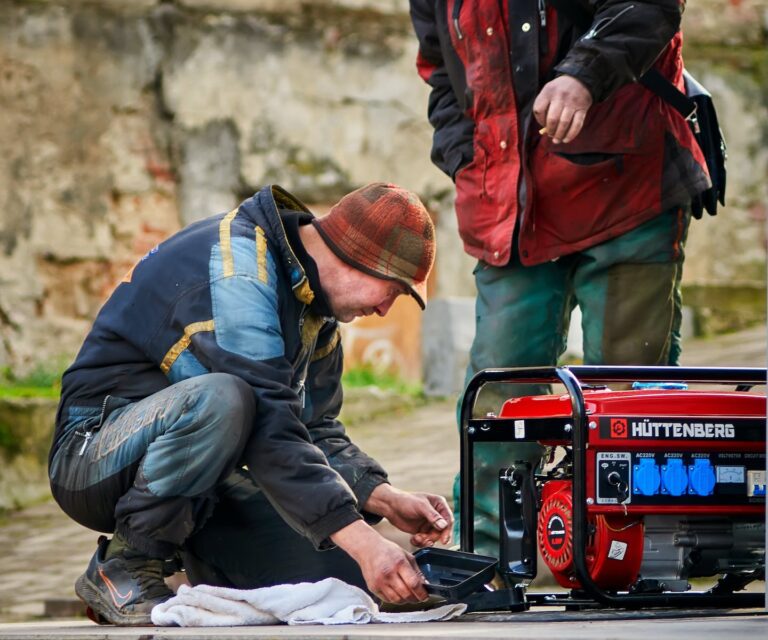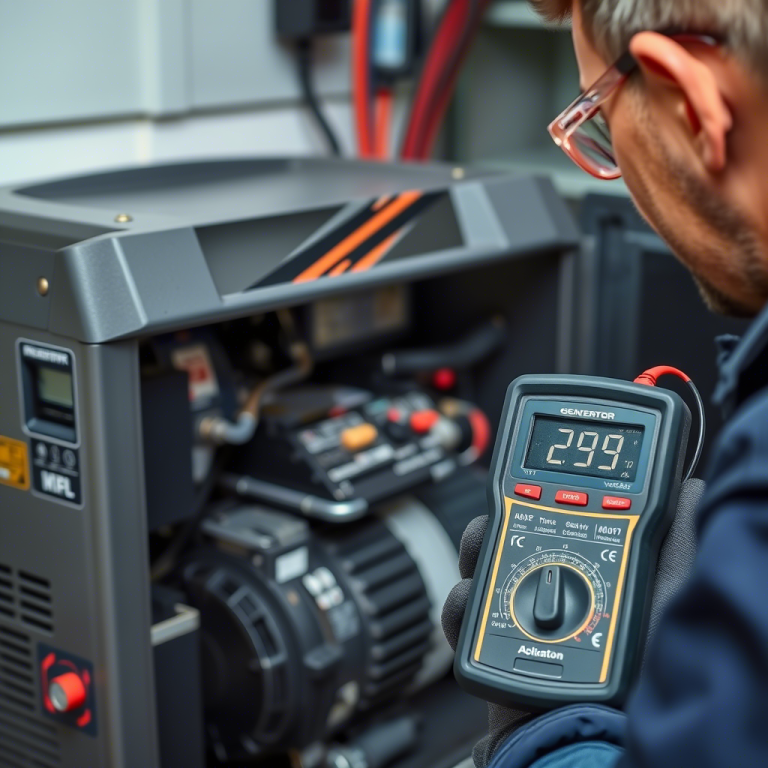What is the typical fuel tank size for a portable generator?
As someone who has dealt with the frustration of running out of fuel during a power outage, I understand the importance of choosing the right fuel tank size for a portable generator.
In this article, we’ll explore the typical fuel tank sizes for portable generators and how they impact performance and usage.
From smaller tanks that require more frequent refueling to larger tanks that offer longer periods of uninterrupted power, we’ll cover everything you need to know about fuel tank size for portable generators.
Key Takeaways
- The fuel tank size for portable generators can vary greatly, typically ranging from 1 to 6 gallons.
- A larger fuel tank allows the generator to run for longer periods of time without needing to be refueled, which is beneficial in emergency situations or when using the generator for extended periods of time.
- A smaller fuel tank means that the generator will need to be refueled more frequently, which can be inconvenient and may limit its usage.
- When choosing a portable generator, consider the size of the fuel tank and how it will affect performance and usage, and select the one that best suits your requirements.
Factors Affecting Fuel Tank Size for Portable Generators
The factors that affect the fuel tank size for portable generators include the generator’s intended usage, power output, and fuel efficiency. These factors play a crucial role in determining the capacity of the fuel tank.
The intended usage of the generator determines how long it needs to run without refueling. For example, if the generator is used for emergency purposes or for extended periods of time, a larger fuel tank is necessary to ensure uninterrupted power supply.
Additionally, the power output of the generator also influences the fuel tank size. Higher power output requires more fuel, thus requiring a larger tank.
Fuel efficiency is another important factor to consider, as a generator with better fuel efficiency can operate for longer periods of time with a smaller fuel tank.
The size of the fuel tank also impacts generator maintenance. With a larger tank, there’s less frequent refueling, reducing the need for constant maintenance.
Importance of Fuel Tank Size in Generator Performance
Having a larger fuel tank significantly improves the performance of a generator by allowing for longer run times without the need for refueling. This is because the size of the fuel tank directly affects how long the generator can operate before running out of fuel. There are several factors that influence the size of a generator’s fuel tank, including the power output of the generator and the intended usage.
The benefits of larger fuel tanks are numerous, including:
- Convenience: With a larger fuel tank, you don’t have to constantly monitor the fuel levels or interrupt your activities to refuel the generator.
- Peace of mind: In emergency situations or during extended power outages, a larger fuel tank ensures that you have a reliable source of power for a longer period of time.
Pros and Cons of Larger Fuel Tanks for Portable Generators
Choosing a larger fuel tank for your portable generator has its advantages and disadvantages.
One of the major advantages is that a larger fuel tank allows for longer run times without the need for frequent refueling. This can be especially beneficial in situations where access to fuel may be limited, such as during emergencies or when using the generator for extended periods of time.
Additionally, a larger fuel tank can help reduce fuel consumption since the generator doesn’t need to be refueled as often.
However, there are also some drawbacks to consider. One of the main challenges of a larger fuel tank is the added weight, which can make the generator less portable and harder to transport.
It’s important to strike a balance between fuel tank size and portability to ensure that the generator meets your specific needs.
Pros and Cons of Smaller Fuel Tanks for Portable Generators
While smaller fuel tanks for portable generators may have their advantages, there are also some drawbacks to consider.
- Maximizing fuel efficiency: Smaller fuel tanks require more frequent refueling, which can be a hassle, especially during emergencies when access to fuel may be limited. This can disrupt the generator’s operation and potentially leave you without power when you need it most.
- Emergency preparedness: In situations where power outages are common or during natural disasters, a smaller fuel tank may not provide enough runtime to sustain essential appliances and keep your family safe and comfortable. It’s crucial to have a generator with a larger fuel tank to ensure a longer duration of power supply during emergencies.
Considering these factors, it’s important to assess your specific needs and prioritize emergency preparedness when choosing the fuel tank size for your portable generator.
How Fuel Tank Size Impacts Generator Usage
The fuel tank size significantly affects my usage of the generator. When it comes to recreational activities, such as camping or tailgating, having a generator with a larger fuel tank allows me to maximize fuel efficiency and enjoy longer periods of power without needing to refuel.
This is especially important when I’m out in remote locations where fuel may not be readily available. With a larger fuel tank, I’ve the peace of mind knowing that I can power my appliances and devices for extended periods of time without interruption.
On the other hand, a generator with a smaller fuel tank would require more frequent refueling, which can be inconvenient and limit the duration of my activities. Therefore, when considering a generator for recreational use, I always prioritize a larger fuel tank to ensure uninterrupted power supply.
Choosing the Right Fuel Tank Size for Your Portable Generator
Because the fuel tank size directly impacts my generator’s performance and usage, it’s important to choose the right size for my portable generator. When considering the fuel tank size, there are several factors that can affect fuel consumption and overall generator usage. Here are some key points to keep in mind:
- Factors affecting fuel consumption:
- The power output of the generator: Higher power output typically results in higher fuel consumption.
- The load on the generator: Running multiple appliances or devices simultaneously can increase fuel consumption.
- Advantages of larger tank sizes:
- Longer run times: A larger fuel tank allows my generator to run for extended periods without needing to be refueled, which is particularly beneficial in emergency situations or when using the generator for long durations.
- Convenience: With a larger tank, I can use my generator for activities such as camping or tailgating without the hassle of frequent refueling.
Considering these factors and advantages, it’s essential to choose a fuel tank size that aligns with my specific needs and usage requirements.
Common Fuel Tank Sizes for Portable Generators
During my research, I discovered that common fuel tank sizes for portable generators range from 1 to 6 gallons. The fuel tank capacity is an important consideration when choosing a generator as it directly affects the generator’s fuel consumption and runtime.
A larger fuel tank allows for longer periods of operation without the need for refueling, making it ideal for emergencies or extended use. On the other hand, a smaller fuel tank may require more frequent refueling, which can be inconvenient in certain situations.
When deciding on the appropriate fuel tank size for your portable generator, it’s essential to consider your specific needs and usage requirements. Ultimately, choosing a generator with the right fuel tank size will ensure that you have a reliable and efficient power source whenever you need it.
Understanding Run Time and Fuel Efficiency With Different Tank Sizes
How does the size of the fuel tank affect the run time and fuel efficiency of a portable generator?
Well, the size of the fuel tank plays a crucial role in maximizing generator runtime and fuel efficiency. Here’s why:
- With a larger fuel tank:
- You can enjoy longer periods of uninterrupted power, which is especially important during emergencies.
- You can go camping or tailgating without worrying about frequent refueling, allowing you to fully enjoy your outdoor activities.
- On the other hand, with a smaller fuel tank:
- You may need to refuel more frequently, which can be inconvenient and disrupt the flow of your activities.
- Fuel consumption analysis shows that smaller tanks may limit the generator’s usage, especially for extended periods of time or in remote locations.
Fuel Tank Size Considerations for Emergency Situations
In an emergency situation, having a larger fuel tank for my portable generator is crucial for extended power supply. A larger fuel tank allows for a longer runtime without the need for frequent refueling. This means that you can have a continuous power supply during critical times without worrying about running out of fuel.
When it comes to emergency preparedness, it’s important to consider the fuel consumption of your generator. In emergency situations, where power outages can last for hours or even days, having a generator with a larger fuel tank ensures that you have enough fuel to keep your essential appliances and devices running. It provides peace of mind knowing that you’re prepared for any unforeseen circumstances that may arise.
Tips for Maximizing Fuel Efficiency With Different Tank Sizes
To maximize fuel efficiency with different tank sizes, I’ve found a few helpful tips:
- Maintain the generator regularly:
- Regular maintenance, including oil changes and spark plug replacements, can improve fuel efficiency.
- Keeping the generator clean and free of debris can also contribute to better fuel efficiency.
- Use fuel-saving techniques:
- Avoid running the generator at full load if it’s not necessary, as this consumes more fuel.
- Consider using a power strip to connect multiple devices, rather than plugging them directly into the generator.
By following these tips, you can make the most out of your generator’s fuel tank size and save on fuel consumption.
Maximizing fuel efficiency not only saves you money but also reduces the environmental impact of generator use. So, make sure to implement these fuel-saving techniques for an efficient and eco-friendly power supply.
Conclusion
In conclusion, when it comes to choosing the right fuel tank size for a portable generator, it’s important to consider your specific needs and usage requirements. A larger fuel tank allows for longer periods of uninterrupted power, while a smaller fuel tank may require more frequent refueling.
Ultimately, the fuel tank size directly impacts the generator’s performance and usage, so it’s crucial to select a size that best suits your needs.



